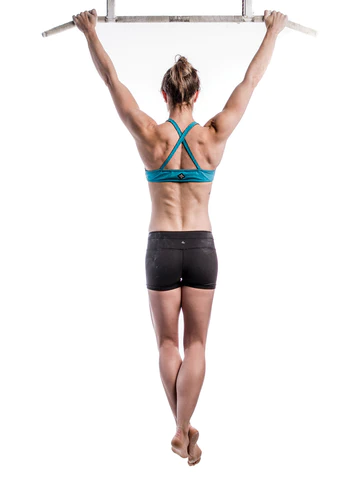Hang from a bar. Sounds easy, right? Maybe even boring or pointless or needlessly repetitive, much like listening to your spouse 1 it’s cool, she doesn’t read this. But, to test that out, I’ve spent the last 30 days in a hang position 2meaning, I hung every day for 30 days…not that I hung for 30 days straight. And here are my real-world results, including changes in my grip strength, the mass gained in my forearms, changes in my shoulder mobility, and more.
If you scour YouTube or the net, you’ll see that passive / dead hangs or active hangs are recommended for all kinds of maladies. Shoulder pain? Just dead hang. Poor grip? Dead hang. Shoulder blade 3scapula issues? Hate your life? Just hang, man.

In fact, if you follow someone like movement guru Ido Portal you’ll find that he recommends 7 minutes (!) of simply hanging every day. And while 7 minutes sounds brief, after doing this for 30 days, I can tell you it’s not. Much like listening to MSNBC, it will feel like an eternity.
So with that in mind, I decided to just hang. Every day. Multiple times a day. Anywhere from 3 to 4 minutes per day. So what were my results? Well, I’m glad I asked. If you’re interested in just the results, feel free to skip ahead.
Overview - I hung from a bar for 30 days, totaling anywhere from 3 to 4 min per day - My max hang time before the challenge was 84 seconds - My max hang time after the challenge was 96 seconds, a 14% increase - I did not increase muscle mass in my forearms - Other benefits - some major and some minor - were also experienced (read on!)
But, briefly, I want to discuss the “before” part. What did I hope to accomplish? How long could I hang before? What (and why) was my daily hang workout routine?
Challenge Goals
- Increase shoulder range of motion
- Reduce shoulder pain
- Increase grip and forearm strength
- Spinal decompression
- Better posture
That’s a lot possible benefits just for simply hanging from a bar but that’s what proponents claim. So I wanted to keep that in mind and evaluate those claims during and after the challenge.
Plus, there was a bit of mental challenge there too. Could I do something for 30 straight days? Could I channel my inner Tony Robbins and push through any mental exhaustion?
Before
I started the hang challenge on June 5th 2022. In order to get a baseline on my endurance, I did a couple warm up sets and then went for a max dead hang from a pull up bar. Here’s what I could do on that date with an overhand grip (palms away, like in a pull up):
- Max dead hang: 1 min, 24 seconds (84 seconds) at a bodyweight of 193.4 lbs

As for my forearm size, it measured at 12.375″ cold. Cold meaning I did not exercise or otherwise “pump” the muscle before hand.
So, while not horrible overall, I definitely wouldn’t call those numbers great either. I don’t know what the average dead hang time is but there was, shall we say, some room for improvement.
On a side note, that got me wondering what is the world record dead hang? Well, according to Guinness 4not the beer company, the world record one, it’s an astounding 16 minutes, 3 seconds. So, yeah, probably not breaking that one anytime soon (or ever). Moving on…
My Hanging Routine
Based on my max dead hang, I decided I need to go for at least 2x that amount of accumulated time per day. So, I originally dead hanged (hung?) around 1 min 30 seconds. Doubling that time means my goal was at least a total daily hang time of 3 minutes.
That time, though, was not consecutive. Instead, I chunked it up into 15/30 second intervals multiple times a day. So, for example, maybe in the morning I did 2 30 second intervals for a time of 1 minute. Then I did the same in the afternoon and evening until I reached my total target time.
Can’t hang for 3 minutes a day? No problem; just do a max hang from bar for time and then make a realistic daily goal based on that. Maybe that’s 30 seconds a day or maybe it’s 7 minutes a day. Whatever it is, the important thing is to have a goal to hit.
To that end, instead of overthinking the how, I really wanted to focus more on the volume or time under tension. For me, that meant keeping it simple and setting the following targets:
- Weeks 1 and 2: 3 minutes per day of the hanging position
- Weeks 3 and 4: 4 minutes per day of the hanging position
Why the bump in time during the third and fourth week? Well, in my mind, I anticipated I would’ve become more acclimated to hanging by then and should (theoretically) be able to hang longer. Again, pretty simple.
Plus, like I mentioned above, I really wanted to get additional training volume in and adding additional time was the easiest way to do that.
Equipment
I used the following equipment for my hangs:
- A standard pull-up bar
- My Metolius climbing hang board
- My watch or a gym timer
Why the hang board? One, it just gives a different stimulus than a normal pull up bar. Namely, it allowed me to work on some finger strength. And, two, it made it more “fun” as I could try different varieties quickly and easily.
Don’t have either a bar or board? Use rings. No rings? Easy, you can hang from a tree branch. No trees? Find some monkey bars at a playground. In reality, any of those are great as the different sizes and textures add some more challenge to your normal dead hang. Personally, I used monkey bars intermittently as my schedule allowed.
How I Did My Hanging

Different Grips
For my hangs, I also did a mix of both overhand grip, 5palms away, also known as pronated, underhand grip 6palms facing me, also known as supinated and occasionally a neutral grip dead hang 7 palms facing each. In other words, I tried to work both pull up grip strength and chin up grip strength and a combination of the two.
I also spaced my hands out differently – sometimes quite bit wider than shoulder width and sometimes at or narrower than shoulder width. Again, I didn’t overthink this part of it as I just wanted make it a little more “fun” than it otherwise would be.
Different Hang Types
Additionally, depending on how I felt, I either did a dead hang, an active hang, or a dynamic hang.
- A dead hang – or the passive dead hang position – is where you have arms straight and relaxed shoulder blades. In short there’s no tension other than in your grip and that tension is solely from your body weight and gravity.
- Active hangs are similar to dead hangs but you actually have your shoulder blades activated or retracted. They’re a bit more difficult due to the necessary shoulder blade activation.
- Dynamic hangs are a combination of passive and active hanging along with some swinging movements (side-to-side or back and forth).
You can see the difference below:

I predominantly used my body weight although, on a few occasions I actually used a weight vest for an additional challenge. I also used both a narrow grip and a wide grip. In short, I tried to get a ton of different dead hang variations in each day and week.
If you’re super strong, you could also try to do a single arm dead hang. While I can hold one for a little bit, it’s too challenging for me to hold for a long time. As such, other than occasionally doing it for fun, I skipped any single arm versions.
Initial Thoughts
So, how’d it go? Well, I underestimated the amount of soreness and fatigue I would experience early on. As such, I decided to take 1 day off per week for recovery. So, technically it wasn’t 30 consecutive days but, yeah, I’m counting it. Besides that, though, I grinded thru my daily and weekly routine.
Now, it wasn’t always easy. In fact, it rarely was and there were quite a few days where I had to do a minute or two of hanging pretty late at night just to hit my total time. But, just so I could type this up, I stuck with the workout as I intended. One thing to note, I didn’t adjust my prior workout routine and just added the hangs on top of that.
Challenge Results
So, after 30 days, where did I stand? Well, let’s group the results by body area and compare them to my initial goals:
Shoulders
If you remember, I had two main goals when it came to shoulders:
- increase overhead range of motion
- reduce pain.

After 30 days of hanging, I can say without a doubt that my range of motion increased. While it was hard to measure, I would guesstimate it was about a 7-10 degree improvement on my overhead range of motion on my impinged shoulder. My the mobility of my other shoulder was also slightly improved but probably no more than a degree or two. So, shoulder joint range of motion was a success.
Now to shoulder injury repair…I’ve seen YouTube videos claim that hanging exercises will fix your shoulder pain. I was skeptical then and my results did nothing to change that. Yes, my pain has been somewhat reduced but it absolutely did not eliminate it.
Is it because my shoulder injury is that bad? Is it because it takes longer than 30 days? At this point, I’m not sure but I reckon that I need some shoulder strength training – specifically around my rotator cuff – to eliminate the pain.
Shoulder success rating: 6.5/10
Back
The biggest surprise from daily dead hangs was realizing just how tight my lat muscles were. Without getting into anatomy too much, the lats originate on your lower spine, iliac crest, inferior ribs, and scapula.

What’s that mean? Well, if your lats are too tight (like mine) it can absolutely negatively affect your spinal, back, and shoulder mechanics. By hanging, I noticed a big stretch and better motion in my lower, outside lats and that improvement helped reduce tension on my back. It also improved my scapular motion (although not to a huge degree) – which ties into shoulder health.
In terms of spinal decompression, yes, there is some temporary relief and elongation of the spine from hanging. But, did that make a noticeable difference? Not for me. I suspect some inversion boots or an inversion table would give you better results simply due to the fact you can hang out (haha) in that position for a longer period of time.
Lastly, I noticed a slight improvement in posture. Namely, my shoulders were more naturally “open” (i.e. not as rounded forward, which is a huge problem for a lot of folks) than before. I suspect, though, you could get the same effect just by positional awareness and realizing when they are rounded forward and consciously resetting them to a better position.
Back success rate: 8/10
Forearm Strength and Size
Remember, before the challenge my max bar hang for length with a pull up grip was 1 min 24 seconds. After 30 days (and taking 2 days of rest), my max hang for length was 1 min 36 seconds.
That’s a 14% increase over my baseline. To be honest, I was expecting more but that’s still a pretty decent increase in just a month.
I suspect if I did the challenge again, I’d have further improvements although to a lesser degree. I would also throw in some longer hold periods and occasionally take longer rest periods. Otherwise, though, I think my initial plan worked out pretty well.

Now, in terms of size, before the challenge my forearm measured 12.375″ in circumference. Afterwards, they measured in at 12.5″ which is a 1% increase. In short, it’s basically a rounding error and I didn’t experience any change in muscle mass in my forearms. So, as a you see I gained a lot more endurance strength (14%) than muscle mass (1%).
While the dead hang exercise is for your upper body, I wouldn’t necessarily call it an upper body exercise 8 that made more sense in my head. What I mean to say is, it’s a limited upper body exercise in that really only works a small portion of your upper body muscles.
Buuttttt, man, it does have some transference over to other exercises. What do I mean? Well, for example, because my grip is a lot stronger, I find it easier to do pull ups and chin ups. I can trap bar deadlift better/heavier too. So not only do I have a strong grip, that grip directly (or indirectly affects) my entire body. Pretty cool.
Grip is a pretty important factor is almost every sport – think of the grip battle in BJJ or Judo, or holding on to a golf club, bat, or tennis racket. So if you’re an athlete, hanging has some great transference and is highly recommended.
Grip success rate: 7.5/10
TL;DR (Final Thoughts)
Overall, I would call the 30 day hang challenge an enjoyable success. In fact, I plan on doing some other 30 days challenges. Anyways, not only did I significantly improve my grip strength endurance by 14% – which transfers over to real world activities and lifting weights – but I also improved my shoulder mobility and (slightly) reduced my shoulder discomfort.
Not only can dead hanging be done from virtually anywhere by anyone, it can be done with no equipment just using your entire body weight. It’s a simple, great exercise but it’s not a silver bullet nor should it be billed as such. It’s much like any other exercise you do – it’s a proverbial tool to keep in your toolbox and should be used to address specific items (like grip strength or shoulder range of motion).
In short, while not in the pantheon of upper body exercises I do think regularly hanging – even if it’s not 30 day straight – has some great overall mobility and strength benefits and it’s something I plan on continuing. So start hanging and happy training. If you do, give me a shout and let me know how it worked for you!












